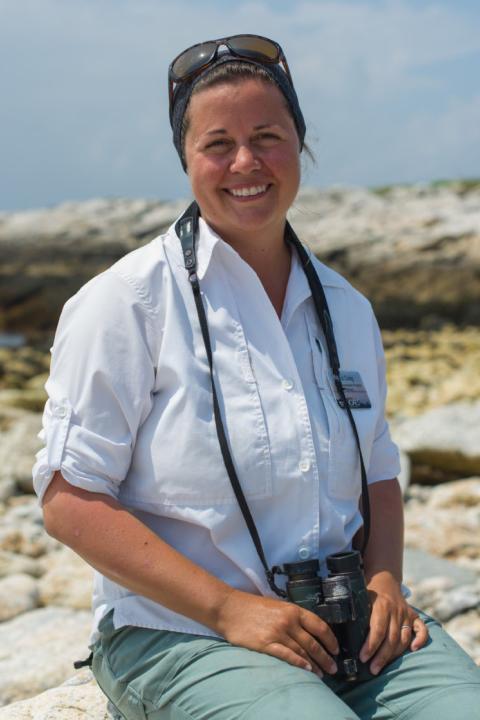
Elizabeth Craig
Education
- Ph.D., Zoology and Wildlife Conservation, Cornell University
- B.A., Columbia University
Research Interests
- Migratory Animals and Birds
- Ecology
- Marine Biology
- Ornithology
- Wildlife & Habitat Management/Conservation
- Fish and Fisheries
- Birds - Habitat
- Telemetry
- Climate Change - Impacts
- Toxic Substances--Environmental
- Fieldwork
- Endangered Species
Selected Publications
Laird, L. S., Craig, E. C., Clucas, G., Taylor, V. F., & Chen, C. Y. (2024). Mercury bioaccumulation in three colonial seabird species in the Gulf of Maine.. Sci Total Environ, 947, 174438. doi:10.1016/j.scitotenv.2024.174438
Brosseau, J. E., Eddington, V. M., Craig, E. C., White, E. R., & Kloepper, L. N. (2024). The effect of localized disturbance on the acoustic behavior of the common tern (Sterna hirundo).. JASA Express Lett, 4(9). doi:10.1121/10.0028204
Legett, H. D., Lucas, J. R., Craig, E. C., & Staudinger, M. D. (2023). Variation in isotopic niche partitioning between adult roseate and common terns in the Northwest Atlantic. Endangered Species Research, 50, 235-247. doi:10.3354/esr01233
Smith, O., & Craig, E. (2023). Effects of Atlantic butterfish ( Peprilus triacanthus ) in diets of Common Terns ( Sterna hirundo ): a case study of climate change effects in the Gulf of Maine. Avian Conservation and Ecology, 18(2). doi:10.5751/ace-02440-180201
Craig, E. C., Moore, G. E., & Seavey, J. R. (2022). Hypersaline spray increases habitat heterogeneity and nesting density in an island-nesting seabird. WILDLIFE SOCIETY BULLETIN, 46(3). doi:10.1002/wsb.1301
Caldwell, A., Brander, S., Wiedenmann, J., Clucas, G., & Craig, E. (2022). Incidence of microplastic fiber ingestion by Common Terns (Sterna hirundo) and Roseate Terns (S. dougallii) breeding in the Northwestern Atlantic. MARINE POLLUTION BULLETIN, 177. doi:10.1016/j.marpolbul.2022.113560
Caldwell, A., Seavey, J., & Craig, E. (2020). Foraging strategy impacts plastic ingestion risk in seabirds. LIMNOLOGY AND OCEANOGRAPHY LETTERS, 5(1), 163-168. doi:10.1002/lol2.10126
Bracey, A., Lisovski, S., Moore, D., McKellar, A., Craig, E., Matteson, S., . . . Cuthbert, F. (2018). Migratory routes and wintering locations of declining inland North American Common Terns. The Auk, 135(3), 385-399. doi:10.1642/auk-17-210.1
Craig, E. C., King, D. T., Sparks, J. P., & Curtis, P. D. (2016). Aquaculture depredation by double‐crested cormorants breeding in Eastern North America. The Journal of Wildlife Management, 80(1), 57-62. doi:10.1002/jwmg.989
Craig, E. C., Elbin, S. B., Sparks, J. P., & Curtis, P. D. (2015). Identifying Important Foraging Habitat for Colonial Waterbirds in an Urban Estuary: a Stable Isotope Approach. Waterbirds, 38(4), 330-338. doi:10.1675/063.038.0410
Craig, E. C., Dorr, B. S., Hanson-Dorr, K. C., Sparks, J. P., & Curtis, P. D. (2015). Isotopic Discrimination in the Double-Crested Cormorant (Phalacrocorax auritus).. PLoS One, 10(10), e0140946. doi:10.1371/journal.pone.0140946
Craig, E. C., Elbin, S. B., Danoff-Burg, J. A., & Palmer, M. I. (2012). Impacts of Double-Crested Cormorants (Phalacrocorax auritus) and Other Colonial Waterbirds on Plant and Arthropod Communities on Islands in an Urban Estuary. Waterbirds, 35(sp1), 4-12. doi:10.1675/063.035.sp102